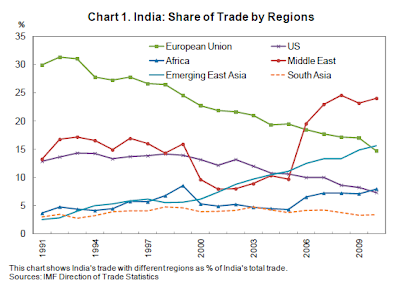Government transfers from India, both grants and loans, especially to the smaller countries like Bhutan, Nepal, and Maldives are significant. However, the level of private sector integration - apart from remittance flows of migrant workers in India, especially of workers from Bangladesh, Maldives, and Nepal - has remained small. A major source of spill-over from India is in human capital formation arising from students studying in India, administrative capacity building, and Indian support for health and education sectors in these countries.
The estimation suggests that an increase in growth in India by 1 percentage point is correlated with a rise in growth in South Asian Countries (SAC) economies by 0.37 percentage points... (other studies) show that a 1 percentage point increase in GDP per capita growth in South Africa is correlated with a 0.5–0.7 percentage point rise in growth in the rest of Africa for the period 1980–99. They also find a 1 percentage point increase in China’s growth is correlated with an average of 0.5 percentage point increase in the growth of the rest of the world for the last two decades, with potentially larger effects for Asian countries.
India's trade, both as a share of global trade and in absolute volumes, has multiplied in the last decade and half. However, even as its trade with all emerging economies and regions have grown dramatically, its trade with its neighbours has remained stagnant.

The Southern African Customs Union (SACU) has aided the closer integration of the five regional economies and helped the smaller countries benefit from South Africa's economic vibrancy. In fact, since trade is tariff-free within the region, South Africa accounts for more than 80 percent of the imports of the smaller members of the South Africa Region (SAR). But they have been also able to build solid export markets outside South Africa. In contrast, the share of trade of India's SAARC neighbours has been very small. While the trade shares of Afghanistan and Pakistan are understandable, the relatively small share of trade that Sri Lanka and Bangladesh have with India is surprising.

Infrastructure, especially energy, railways, and telecommunications, offers exciting opportunities for co-operation between these economies. The smaller economies could benefit immensely from leveraging India's expertise in these sectors. While the Indian government will have to facilitate the strengthening of this mutually beneficial partnership with long-term loans and other forms of aid, India's private sector may have to seize the opportunities that are slowly emerging in these countries. Some form of strategic diplomacy to deepen such links is the need of the hour
Closer economic relationship will not only add another, probably critical, growth dimension to these economies, but also help alleviate the mistrust that characterize political relationships among countries in the region. For India, it will lay the foundation for smoother relationships in its "near abroad" so that its more ambitious global ambitions can be pursued.
No comments:
Post a Comment